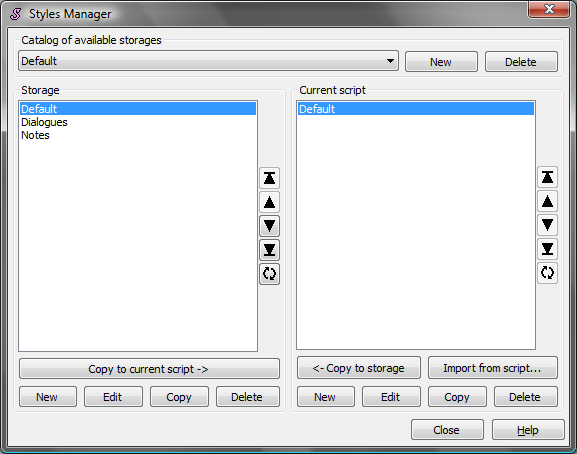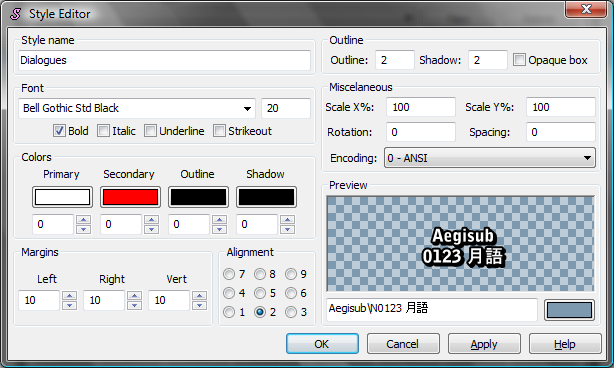Styles
From Aegisub Manual
A style in the ASS format is a set of typographic formatting rules that is applied to dialogue lines. The style parameters can be overridden with override tags; the styles exist so that you won't have to type out all the overrides for each line.
[edit] The styles manager
Aegisub's styles manager tool (accessed from the Subtitles menu) provides various means of organizing, saving and editing styles. It looks like this:

As you can see, the window is divided into two halves. The right half displays all styles that you currently have accessible in your currently loaded script; the left represents a style storage. Style storages are used by Aegisub to let you save styles and quickly import them into scripts. You can have as many storages as you want; some people prefer to keep all their styles in one storage, others sort their styles by font, by show or alphabetically. The dropdown menu at the top lets you choose what storage you want to view.
In the bottom part of the window there's two almost identical sets of buttons; one set for the storage and one for the current script. They are:
- New - Create a new style, either in the storage or in the current script.
- Edit - Edit the selected style using the style editor (see below).
- Copy - Create a copy of the selected style and bring up the style editor for it.
- Delete - Delete the selected style(s).
- Copy to script and Copy to storage - copies the selected styles between the storage and the current script.
- Import from script - Lets you import one or more styles from another script to the current one.
Pressing Ctrl-C in the styles manager will copy the selected style(s) to the clipboard as a text string. This also works the other way around; you can copy one or more style lines from another program and press Ctrl-V (paste) in the styles manager; this will insert them into the current script.
[edit] The style editor
Pressing the "Edit" button or doubleclicking a style name will bring up the style editor, which lets you tweak all the parameters available. Note: some parameters that are available as override tags (i.e. \be) are not available as style parameters; conversely, some parameters that are available in the styles editor (i.e. the "opaque box" outline option) are not available as a style override. This is an unfortunate and occasionally annoying format limitation.
To return to the style editor:

- Style name - The name of the style. You can't have two styles with the same name in the same script.
- Font - This section controls the font settings. The dropdown menu lets you choose the typeface (any font installed on your system will show up in this list) and the number to the right controls the size in points. The checkboxes below set the bold/italic/underline/strikeout parameters.
- Colors - This controls the four text colors (primary, secondary, outline and shadow). The meaning of each of them is as follows:
- Primary - used as the "fill" (main) color of the text.
- Secondary - secondary fill color, only used for karaoke effects (see \k and its relatives on the override tags page).
- Outline - used as outline (border) color.
- Shadow - used as shadow color.
- The four colored boxes show you the current color for each of the four text colors; clicking on them opens the color picker. The spin controls/number boxes below each colored box controls the transparency of that color. The transparency (or "alpha") is given as a number between 0 (opaque) and 255 (completely transparent).
- Margins - Controls how close to the borders of the video frame the text will be positioned (and hence also when automatic linebreaking will kick in; but do note that there is no option for text justification). Each value (left, right, vertical) is given in script resolution pixels (see script properties). For alignments (\an) 1-3, the vertical margin is relative to the bottom of the video frame; for 4-6 it doesn't have any meaning, and for 7-9 it is relative to the top of the video frame.
- Alignment - Controls the alignment of the text. The numbers correspond to the arguments to the \an tag. Alignments 1, 4 and 7 are flush left; 3, 6 and 9 are flush right; 2, 5 and 8 are centered. 1, 2 and 3 are "subtitles" (i.e. drawn at the bottom of the frame); 4, 5 and 6 are "midtitles" (i.e. centered vertically on the frame); 7, 8 and 9 are "toptitles" (i.e. drawn at the top of the frame). Do note that there is no such thing as a justified alignment; this is a format limitation.
- Outline - Controls the outline (border) thickness (and style) and the shadow offset.
- For the outline, the number is the thickness of the border in script pixels if ScaledBorderAndShadow is enabled (see script properties); if it is disabled the thickness is given in video pixels instead. Setting it to 0 disables the outline.
- The shadow on the other hand is basically a copy of the main text, and the number controls how far downwards and to the right the shadow is drawn from the main fill. It's given in script pixels if ScaledBorderAndShadow is enabled, video pixels otherwise. Setting it to 0 disables shadow.
- Finally, the checkbox marked "Opaque box" controls whether the outline should be drawn as described above (which happens if it is unticked), or replaced by an opaque background bounding box.
- Miscellaneous - this section has various other parameters, namely:
- Scale X and Scale Y - Controls text stretching in the horizontal (X) and vertical (Y) direction respectively. The value is given in percent, so 100 means no stretching is done. You should not use this for normal text sizing; use the point value in the Font area instead since that uses hinting information from the font.
- Rotation - Controls rotation of the text. The value is the angle of the rotation in degrees (360 degrees to a full circle) and may be negative or larger than 360 (setting it to 360, 720 etc is the same as setting it to 0).
- Spacing - Controls the horizontal spacing between letters. 0 means the font defaults are used. May be negative for less spacing, or positive for more. It is currently unknown what unit is used.
- Encoding - Controls which codepage is used to map codepoints to glyphs; it has nothing to do with the actual text encoding of the script. This is only meaningful on Windows using VSFilter, where it is used to get some old (particularly Japanese) fonts without proper Unicode mappings to render properly. On other systems and renderers, Freetype2 provides the proper mappings. If you didn't understand a word of the above, pretend this setting doesn't exist.
- Preview - Shows a preview of what the text will look like using the current style parameters. The text field lets you input some sample text to preview, and the colored box controls the color of the background.